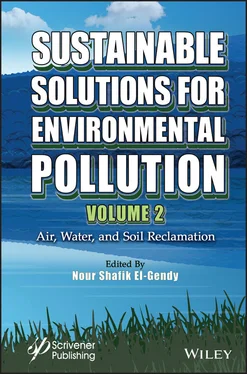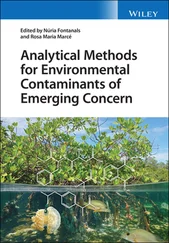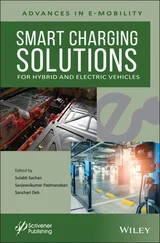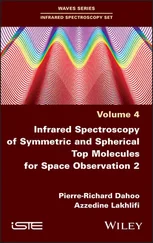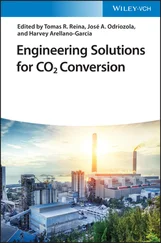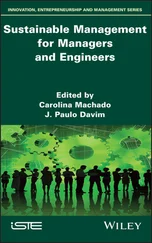Sustainable Solutions for Environmental Pollution, Volume 2
Здесь есть возможность читать онлайн «Sustainable Solutions for Environmental Pollution, Volume 2» — ознакомительный отрывок электронной книги совершенно бесплатно, а после прочтения отрывка купить полную версию. В некоторых случаях можно слушать аудио, скачать через торрент в формате fb2 и присутствует краткое содержание. Жанр: unrecognised, на английском языке. Описание произведения, (предисловие) а так же отзывы посетителей доступны на портале библиотеки ЛибКат.
- Название:Sustainable Solutions for Environmental Pollution, Volume 2
- Автор:
- Жанр:
- Год:неизвестен
- ISBN:нет данных
- Рейтинг книги:3 / 5. Голосов: 1
-
Избранное:Добавить в избранное
- Отзывы:
-
Ваша оценка:
- 60
- 1
- 2
- 3
- 4
- 5
Sustainable Solutions for Environmental Pollution, Volume 2: краткое содержание, описание и аннотация
Предлагаем к чтению аннотацию, описание, краткое содержание или предисловие (зависит от того, что написал сам автор книги «Sustainable Solutions for Environmental Pollution, Volume 2»). Если вы не нашли необходимую информацию о книге — напишите в комментариях, мы постараемся отыскать её.
This second volume in a broad, comprehensive two-volume set, “Sustainable Solutions for Environmental Pollution”, concentrates on air, water, and soil reclamation, some of the biggest challenges facing environmental engineers and scientists today.
AUDIENCE: Sustainable Solutions for Environmental Pollution,
Sustainable Solutions for Environmental Pollution, Volume 2 — читать онлайн ознакомительный отрывок
Ниже представлен текст книги, разбитый по страницам. Система сохранения места последней прочитанной страницы, позволяет с удобством читать онлайн бесплатно книгу «Sustainable Solutions for Environmental Pollution, Volume 2», без необходимости каждый раз заново искать на чём Вы остановились. Поставьте закладку, и сможете в любой момент перейти на страницу, на которой закончили чтение.
Интервал:
Закладка:
Three levels of electro-bioremediation setups exist: 1) bench tests on lab-scale microbial fuel cell (MFC) with a volume <1L; 2) pilot tests on semi-industrial devices (>1 L); and 3) in-field tests on quasi-full-scale. The two first levels deal with Sediment MFCs, and only the last one concerns actually Benthic MFCs.
1.10.4 Bench Tests
Pollutant bench tests, often referred as microcosm studies, focus on the optimization of operational electrochemical parameters. Bench tests reach high removal for contaminants such as: nitrogen salts by cathode ammonification and anode denitrification processes (Zhang et al. , 2020b); crude oil and PAH contaminations (Mohan and Chandrasekhar, 2011; Morris and Jin, 2012; Li et al. , 2014; Lu et al. , 2014a; Viggi et al. , 2015; Venkidusamy et al. , 2016; Daghio et al. , 2017; Kronenberg et al. , 2017; Li et al. , 2017b; Yan et al. , 2017; Yu et al. , 2017; Palma et al. , 2018; Li et al. , 2020; Zhang et al. , 2020b); solvents (Strycharz et al. , 2008; Zhang et al. , 2010; Daghio et al. , 2016); OM (Morris and Jin, 2012; Venkidusamy et al. , 2016; Gonzalez-Gamboa et al. , 2017; Zhao et al. , 2017), or pesticides (Rodrigo et al. , 2014; Cao et al. , 2015; Domínguez-Garay et al. , 2018; Quejigo et al. , 2018). Electro-bacteria can promote reductive remediation of organochlorine compounds (Aulenta et al. , 2011; Yu et al. , 2016). On its side, cathode electrode can remove heavy metal ions by metal reducing and depositing such as for Cu 2+, Ag 2+, and Hg 2+. But, for metal ions with negative reduction potential, such as Pb 2+, Cd 2+, Zn 2+, and Ni 2+, energy input is required for reduction. However, this technique currently works only at bench scale and on synthetic solutions, thus avoiding the problem of metals bound to OM. Only an application on actual wastewater will be able to prove the relevance of electro-bioremediation in treatment of heavy metal pollutions (Bagchi and Behera, 2020).
Since electro-bioremediation involves a microbial consortium, it takes time to become operational: prior enrichment of the electrodes (bio-augmentation) accelerates the biodegradation capacities (Venkidusamy et al. , 2016). The potential difference measurement between the anode and the cathode provides a way to monitor the set up progress of the microbial consortium, and its stabilization time varies with the device size. In bench tests it stabilizes after about 10 days: it takes 2 to 3 days in marine sediment (Najafgholi and Rahimnejad, 2016); 10 days in swamp sediment (Gonzalez-Gamboa et al. , 2017) and Diesel-fed sludge (Venkidusamy et al. , 2016); 13 days in tidal mud (An et al. , 2010); and around 20 days in waterlogged soil (Yu et al. , 2017; Zhang et al. , 2020b). In pilot tests, it stabilizes about some tens of days: 35 days in TF-CWs (Arends et al. , 2014; Schievano et al. , 2017) crude oil contaminated marine sediment (Hamdan and Salam, 2020), and waste-contaminated river sediment (Yang et al. , 2015); over 40 days in FSF-CWs (Oon et al. , 2016). In field-experiments, because of the size, the voltage stabilization time is supposed to be longer.
1.10.5 Pilot Tests
Pilot tests allow systems to be evaluated under more realistic field conditions such as: in waterlogged soil (Lu et al. , 2014a; Lu et al. , 2014b), sediment (Li et al. , 2017a), and wastewater (Wu et al. , 2016). The bioremediation system requires an anode in anaerobic zones and a cathode in contact with oxygen; both zones are naturally located in CWs. From merging of CWs and BMFC concepts emerges a new setup: the BMFC-CW to simultaneously improve wastewater treatment capacity and produce power (Jeon et al. , 2012; Yadav et al. , 2012; Doherty et al. , 2015; Song et al. , 2017). GHG production can be minimized and even suppressed (≈98%) by fine tuning of electron fluxes (Liu et al. , 2017; Jobin et al. , 2018). But electrobioremediation can also be merged with other mitigation approaches, such as using selected plants to prevent CH 4and N 2O production (Timmers et al. , 2012; Arends et al. , 2014; Maucieri et al. , 2017) or smart hydraulic management (Mander et al. , 2014; Fang et al. , 2015; Jahangir et al. , 2016; Maucieri et al. , 2017). A smartly managed electricity generation in paddy-fields can mitigate CH 4production (Kaku et al. , 2008; Kouzuma et al. , 2014), even if chemical fertilizer is added (Kamaraj et al. , 2020).
1.10.6 Field Implementations
There are few full-scale field implementations of electro-bioremediation (Kronenberg et al. , 2017). Some deal with BMFC setup in rivers (Donovan et al., 2008; Friedman et al. , 2016), lagoons (Nielsen et al. , 2007; Kaku et al. , 2008), paddy-fields (Kamaraj et al. , 2020), or ponds (Jeon et al. , 2012; Schievano et al. , 2017). Field data are still scarce and conflicting. But the actual CW-BMFC configuration seems site-specific and must be tailored according to its own features (Li and Yu, 2015).
Management potential needs some optimization efforts in order to finer control bioremediation processes. In particular, it requires a fine tuning of the anode potential to adjust the ohmic loss variation, demanding a three-electrode setup, to measure precise and well-controlled electrochemical potential. Microbial consortia change, according to external resistance imposed (Lyon et al. , 2010; Goud and Mohan, 2013; Lu et al. , 2014a; Li et al. , 2017a), favoring some to the detriment of other ones, deeply affecting C, N, and S cycles (Sanchez, 2017). Experimental results show that various microbial consortia are able to produce same power levels, demonstrating their flexibility and resilience (Lyon et al. , 2010). The pathogen fate in a BMFC remains unclear (Morato et al. , 2014). Some studies show its high disinfecting potential (Gajda et al. , 2016; Ieropoulos et al. , 2017). Therefore, BMFC in-field implementing requires further studies on sanitary hazards and biodiversity loss related to the electro-bioremediation.
1.10.7 Maintenance of Aquatic Bioremediation Systems
Like all natural systems, nature-based systems evolve over time. During the evolution of CWs, plants grow, develop, and spread, producing a biomass of increasing importance. With environment closure, the number of plant strata increases and a tendency toward afforestation is observed (climax formation). In order to conserve the purifying properties and biodiversity of CWs, management of the biomass produced and the accumulated sediments is necessary. Management measures are aimed primarily at keeping the system open and ecologically diverse. Annual operating and maintenance costs for CWs are in the range of 3% to 6% of the construction cost (Weiss et al. , 2007).
1.10.8 Biomass Management
Operators use different approaches to aquatic vegetation management. The most common option for SSF-CWs is to harvest the biomass in spring and remove it from the system. The second option is to mow the biomass in late fall, keep it on the surface to isolate it and remove it in early spring. However, if the mowed biomass remains on the ground, then the rain slowly leaches out the accumulated nutrients, organic pollutants, and metals and returns them into the system. Finally, in the absence of autumn mowing, the reeds that remain standing are also subject to decomposition and leaching by rain. Moreover, in common reed, the leaves fall into the wetland and enrich the system with nutrients and pollutants (Vymazal, 2020). The bioaccumulation of metals by aquatic plants is not sufficient to ensure the bioremediation of a waterbody on its own, if the biomass produced is not harvested and exported out of the aquatic environment.
Читать дальшеИнтервал:
Закладка:
Похожие книги на «Sustainable Solutions for Environmental Pollution, Volume 2»
Представляем Вашему вниманию похожие книги на «Sustainable Solutions for Environmental Pollution, Volume 2» списком для выбора. Мы отобрали схожую по названию и смыслу литературу в надежде предоставить читателям больше вариантов отыскать новые, интересные, ещё непрочитанные произведения.
Обсуждение, отзывы о книге «Sustainable Solutions for Environmental Pollution, Volume 2» и просто собственные мнения читателей. Оставьте ваши комментарии, напишите, что Вы думаете о произведении, его смысле или главных героях. Укажите что конкретно понравилось, а что нет, и почему Вы так считаете.
